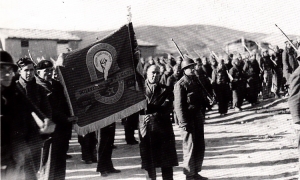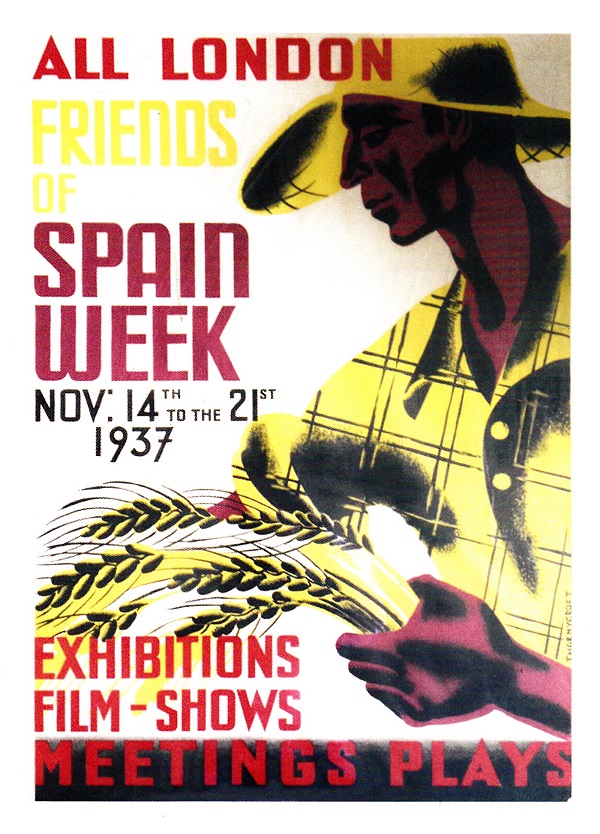
The Spanish Civil War: Three poems by Bob Beagrie
The three poems below are from a sequence of poems inspired by The Spanish Civil War and The International Brigade, which Bob Beagrie been working on for around four years now. It is now a 35 poem collection, Romanceros, and is due to be published next Spring by Drunk Muse Press, a radical Scottish publisher. Recently, Project Lono - Bob and a group of musicians) took eight of the poems from Romanceros and created a 20 minute long dramatic soundscpape of music, sound effects and spoken word recordings. You can hear it on the link below the poems, or here.
Black Sheep
“…it was perfectly clear that if you really saw what
was happening, you felt you had to do something about it.”
- Noreen Branson
(from Angela Jackson’s British Women and the Spanish Civil War)
Grown among grim streets of mangled men
limbless, disfigured, shattered inside and out
like caricatures scribbled by children in crayon,
and the rooms of vacant chairs after Armistice,
they kicked against convention and decorum
refused to know their place, follow instruction
to ask no awkward questions to hear no lies,
but filled with indignation at the shameful state
of the nation, the scale of suffering, deprivation
in smog-laden, rickets-wrung towns and cities,
these rebel children, holy terrors, fiery particles -
libel to run-off, talk back, pick a different track,
flocked together under a new banner to bleat
then stampede, their hooves trampling teapots.

Passage
(for Otto Estensen & Tommy Chilvers)
i)
He plucks the strings of his mandolin
as the sun sinks behind the mountains,
his fingers play a bitter-sweet serenade
as deep blues thicken across the vale,
night drinks returns, sups up the trail,
the mandolin plays across the Pyrenees.
“ay dios mío, ay dios mío, ay dios mío.”
ii)
“Play us a tune for would-be heroes.”
Tommy tells him, beneath icicle stars.
“This is a tune for stars and shepherds.”
He says to pin the tune with a theme.
Both have come a long way from home
to try and lend a hand, to make a stand,
to shed sweat, tears, a drop of blood,
to sleep upon the soil of a foreign land.
iii)
He thrums the strings of the mandolin,
he lets a chord soar, drops the next low.
An owl argues through the cold clear air,
“Hunger teaches the heart how to care.”
Will care be enough against what waits?
What amasses upon each horizon line -
“ay dios mío, ay dios mío, ay dios mío.”
iv)
“Can a tune change the way things are?”
Otto asks, as his fingers stroke the strings,
the bottomless sea of the great night sky
sings along with a song of sovereignty,
the stars outshine the darkening peaks
viewed by two rascals on heaven’s crags?
“A tune can lead us to what we might be.”
Tommy Chilvers mutters with a shiver.
v)
“ay dios mío, ay dios mío, ay dios mío.”
The non-intervention patrols keep watch
for travelling rebels hell-bent for España,
secret passengers of the red express,
but the mandolin has lulled them to sleep,
the mountains snore, the chasms yawn,
the rogues slip through to call ¡NO PASARÁN!
The owl cries for the Republic's dream.
vi)
The tune runs out on the mandolin,
two friends cast away from the familiar
hunker into hollows for a chill night
both have no doubt that they’re right
in asking who they are prepared to be?
What they'll do in the name of democracy?
The narrow paths into Iberia are cloaked
in black and blue but the mandolin's tune
echoes back with hope, “ay dios mío”.

Vagabonds
‘We were an uneven lot, large and small, mostly young, hollow-
cheeked, ragged, pale, the sons of depressed and uneasy Europe’
- Laurie Lee – A Moment of War, 1991
Inconvenient on home turf with your unsavoury beliefs
but far from unloved. Invisible only
to those with titles and a seat at the table.
Unexpected, you came to offer your hand, to help
draw a line in the sand. Smuggled
over borders that turned a blind eye,
drawn to so much rawness in vineyards and olive groves
torn from the soft hands of gentlemen.
You composed anthems
for your blacklisted histories,
I recognise those tunes.
Snows melt on the Sierra. Battle lines
scribbled on archaic maps. The evenings full
of flambéed voices on radio broadcasts
from underground bunkers.
You lived afterwards and always
as Christ in the winepress
under a corpse-soiled shawl of suspicion.








